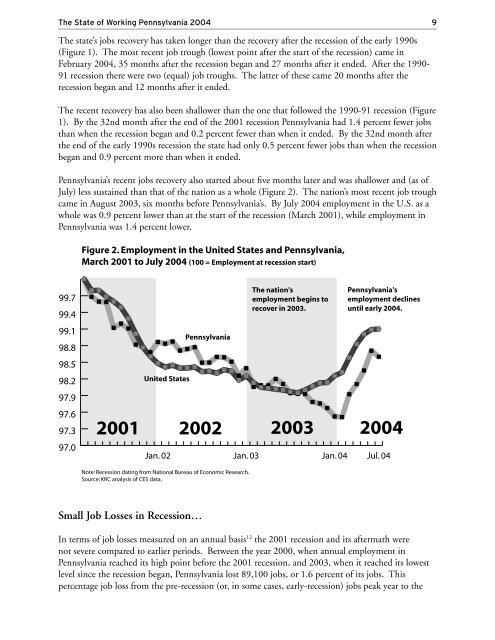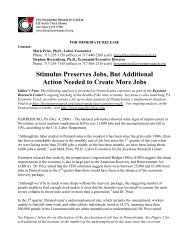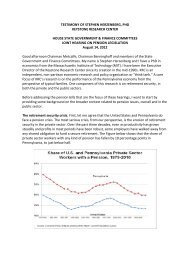The State of Working Pennsylvania 2004 - The Keystone Research ...
The State of Working Pennsylvania 2004 - The Keystone Research ...
The State of Working Pennsylvania 2004 - The Keystone Research ...
Create successful ePaper yourself
Turn your PDF publications into a flip-book with our unique Google optimized e-Paper software.
<strong>The</strong> <strong>State</strong> <strong>of</strong> <strong>Working</strong> <strong>Pennsylvania</strong> <strong>2004</strong> 9<br />
<strong>The</strong> state’s jobs recovery has taken longer than the recovery after the recession <strong>of</strong> the early 1990s<br />
(Figure 1). <strong>The</strong> most recent job trough (lowest point after the start <strong>of</strong> the recession) came in<br />
February <strong>2004</strong>, 35 months after the recession began and 27 months after it ended. After the 1990-<br />
91 recession there were two (equal) job troughs. <strong>The</strong> latter <strong>of</strong> these came 20 months after the<br />
recession began and 12 months after it ended.<br />
<strong>The</strong> recent recovery has also been shallower than the one that followed the 1990-91 recession (Figure<br />
1). By the 32nd month after the end <strong>of</strong> the 2001 recession <strong>Pennsylvania</strong> had 1.4 percent fewer jobs<br />
than when the recession began and 0.2 percent fewer than when it ended. By the 32nd month after<br />
the end <strong>of</strong> the early 1990s recession the state had only 0.5 percent fewer jobs than when the recession<br />
began and 0.9 percent more than when it ended.<br />
<strong>Pennsylvania</strong>’s recent jobs recovery also started about five months later and was shallower and (as <strong>of</strong><br />
July) less sustained than that <strong>of</strong> the nation as a whole (Figure 2). <strong>The</strong> nation’s most recent job trough<br />
came in August 2003, six months before <strong>Pennsylvania</strong>’s. By July <strong>2004</strong> employment in the U.S. as a<br />
whole was 0.9 percent lower than at the start <strong>of</strong> the recession (March 2001), while employment in<br />
<strong>Pennsylvania</strong> was 1.4 percent lower.<br />
<br />
<br />
<br />
<br />
<br />
<br />
<br />
<br />
<br />
<br />
<br />
<br />
<br />
<br />
<br />
Small Job Losses in Recession…<br />
<br />
<br />
<br />
<br />
<br />
<br />
<br />
<br />
<br />
<br />
<br />
<br />
In terms <strong>of</strong> job losses measured on an annual basis 12 the 2001 recession and its aftermath were<br />
not severe compared to earlier periods. Between the year 2000, when annual employment in<br />
<strong>Pennsylvania</strong> reached its high point before the 2001 recession, and 2003, when it reached its lowest<br />
level since the recession began, <strong>Pennsylvania</strong> lost 89,100 jobs, or 1.6 percent <strong>of</strong> its jobs. This<br />
percentage job loss from the pre-recession (or, in some cases, early-recession) jobs peak year to the







